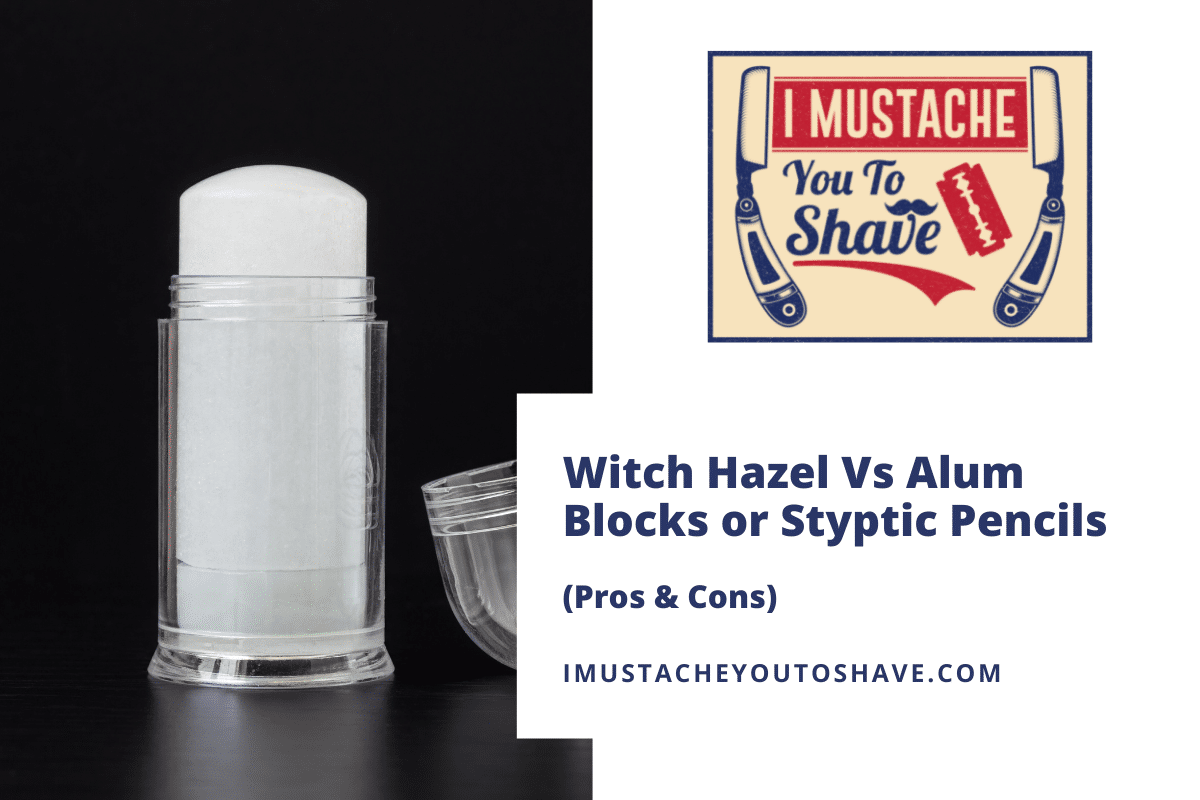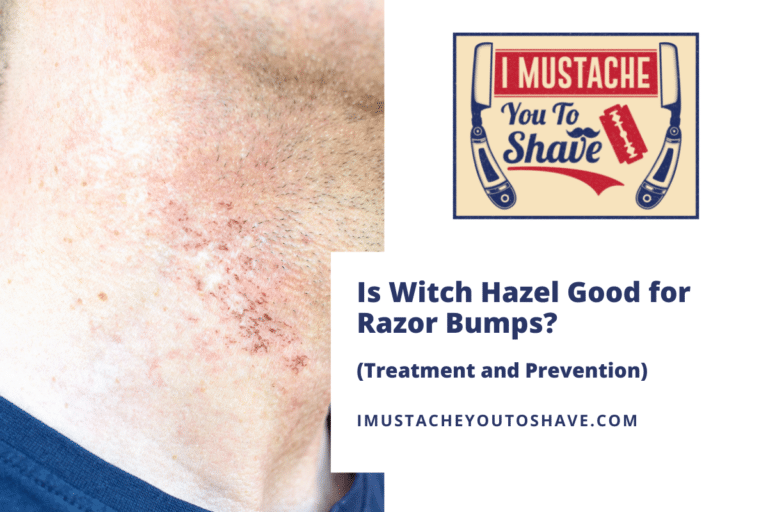Witch Hazel Vs Alum Blocks or Styptic Pencils (Pros & Cons)
If you are a wet shaver, you’ve certainly experienced small nicks or cuts after a shave. There are several aftershave options to help treat these minor skin irritations.
Witch hazel, alum blocks, and styptic pencils can all be effective at stopping bleeding and healing cuts. All three choices are astringent but there are some differences. Witch hazel is a liquid astringent with a 14% alcohol content. Alum blocks and styptic pencils both contain alum compounds and are antiseptic in addition to astringent.
If you want to learn more about the differences and pros and cons of each treatment, read on!
Should you use witch hazel, alum blocks, or styptic pencils after a shave?
Witch hazel, alum blocks, and styptic pencils have been used for centuries in the treatment of minor cuts and skin irritations. When all three treatments are available, which one should you choose?
Choosing an aftershave option doesn’t necessarily have to be an either/or choice. While some shavers prefer only witch hazel, alum blocks, or styptic pencils after a shave, other shavers may use a combination of these treatments depending on their end goals.
Witch hazel is commonly used for its astringent and anti-inflammatory properties. This treatment shrinks inflamed skin tissue and closes up pores after shaving. Witch hazel is an attractive choice to soothe skin redness, razor burn, and itching. It can also help decrease bleeding on very small nicks.
Alum blocks are both astringent and antiseptic. Like witch hazel, the astringency of alum deals with redness, razor burn, and itching while the antiseptic properties help kill germs and bacteria on the skin. Alum blocks are also effective at causing blood to coagulate due to cuts.
Styptic pencils also contain alum, but they are manufactured in a pencil or stick form. Instead of being an overall skin soother, like an alum block, styptic pencils allow you to concentrate on a larger nick or cut and pinpoint the treatment.
What is witch hazel?
Witch hazel is a popular shrub in North American gardens due to its winter blooms. It’s a unique plant because it fruits and flowers at the same time.
Witch hazel is an astringent liquid made from the flowering shrub, Hamamelis virginiana. The shrub’s bark is distilled in alcohol to produce a topical, skin-calming solution. Its high tannin content makes it an excellent anti-inflammatory. Witch hazel is one of the few American medicinal plants that is approved by the FDA for use in non-prescription medications.
While witch hazel can stop some minor bleeding, the main benefits are closing up pores, soothing skin, and fighting redness.
Fun Fact: Witch hazel’s name comes from the English word “wyche” meaning “pliant or flexible” and “hazel” due to the plant’s resemblance to the common hazelnut. Some people claim that its twigs have “witching” abilities to locate groundwater and other valuable, underground elements and metals.
How to use witch hazel after shaving
Witch hazel can be used alone or in combination with alum blocks and styptic pencils.
After a razor shave, rinse the skin well and towel dry. Splash witch hazel on the face like you would a toner. Many shavers make this their final step. If desired, you can follow up with a styptic pencil to stop any heavy bleeding.
Before choosing to use witch hazel all over your face, it’s important to consider your skin issues.
Pros
- Soothes redness, razor bumps, and minor skin irritations
- Closes pores & shrinks inflamed skin
- Inexpensive
Cons
- Can be drying to sensitive skin
- Can aggravate rosacea
- Can’t stop heavy bleeding
What are alum blocks?
Alum has a colorful history. This naturally-occurring compound has been lauded for its odor-fighting, color-attaching, skin-soothing results.
Alum blocks are solid, rectangular bars of potassium alum that are used after a shave to decrease skin irritation, stop bleeding and heal minor nicks and cuts. They have both astringent and antiseptic properties.
An alum block’s astringent properties help tighten pores and aid in the coagulation of blood due to minor cuts. The antiseptic properties of alum soothe the skin and eliminate post-razor irritation, bacteria, and redness.
How to use alum blocks after shaving
Using an alum block is a very simple process.
After shaving, wet the alum block with cold water and rub it over the skin’s surface. The clear alum residue will provide a cooling effect to the skin and seal off any nicks and cuts. Since the alum residue can be drying, it can be rinsed off after 30-60 seconds.
Factors like skin type and sensitivity will play a large part in choosing an alum block over witch hazel or a styptic pencil. Let’s also look at the pros and cons of alum blocks.
Pros
- Natural product with minimal ingredients
- Helps prevent razor burn and skin irritation
- Stops bleeding from minor nicks and cuts
- Kills germs and bacteria
Cons
- Can be drying to some skin types
- Can be difficult to find in your local drug stores
- Can deteriorate if stored wet
- Can shatter if dropped
What are styptic pencils?
Styptic pencils also contain alum but in a different form than alum blocks. The alum is often mixed with other ingredients like titanium dioxide or aloe.
Styptic pencils are anti-hemorrhagic topical agents typically made from aluminum sulfate. Like the name infers, the alum is formed into a pencil shape. When applied to a cut, the alum paste causes the small veins and capillaries to close stopping the bleeding.
The pencils come in a variety of sizes and shapes to fit the shaver’s needs and preferences.
How to use styptic pencils after shaving
Witch hazel and alum blocks can be used all over the face. Styptic pencils are made to be used as a spot treatment only.
If you experience any bleeding cuts after a razor shave, wipe off the excess blood. Dip the tip of the styptic pencil in cold water. Dab the wet point of the pencil onto the nick or cut. Let the residue dry. After the bleeding has stopped and the alum residue is dry, wipe off gently with a clean cloth. Make sure the pencil is stored dry.
Styptic pencils can be used for cuts on other parts of the body as well, so they make a beneficial addition to your medicine cabinet. Let’s highlight their pros and cons.
Pros
- Stops bleeding fast
- Design makes it easy to place where you need it
- Easy to find in your local drugstore
- Inexpensive
Cons
- Stings when applied
- Can deteriorate if stored wet
A close shave brings with it the potential for skin issues. Used alone or in combination with each other, witch hazel, alum blocks, and styptic pencils can calm and treat your post-shave skin.







